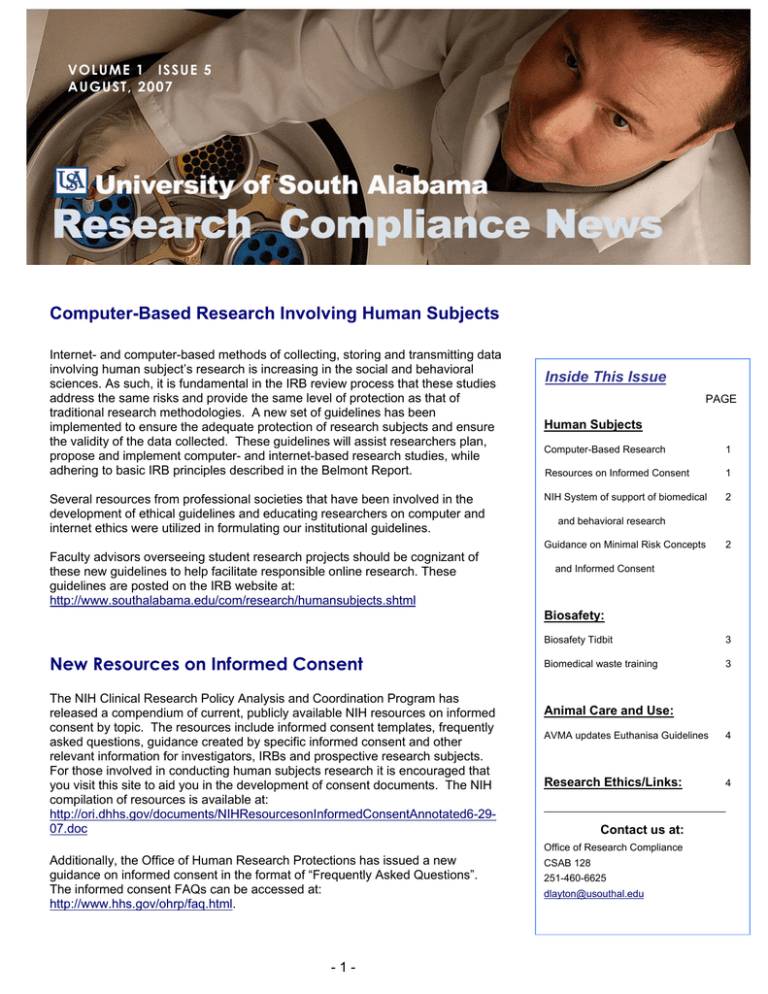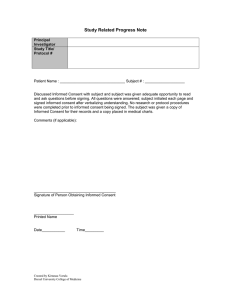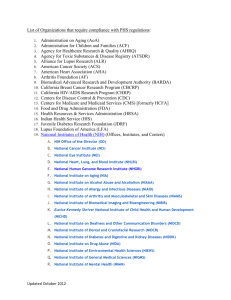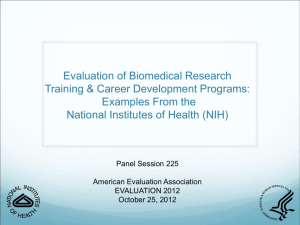Computer-Based Research Involving Human Subjects VOLUME 1 ISSUE 5 AUGUST, 2007
advertisement

VOLUME 1 ISSUE 5 AUGUST, 2007 Computer-Based Research Involving Human Subjects Internet- and computer-based methods of collecting, storing and transmitting data involving human subject’s research is increasing in the social and behavioral sciences. As such, it is fundamental in the IRB review process that these studies address the same risks and provide the same level of protection as that of traditional research methodologies. A new set of guidelines has been implemented to ensure the adequate protection of research subjects and ensure the validity of the data collected. These guidelines will assist researchers plan, propose and implement computer- and internet-based research studies, while adhering to basic IRB principles described in the Belmont Report. Several resources from professional societies that have been involved in the development of ethical guidelines and educating researchers on computer and internet ethics were utilized in formulating our institutional guidelines. Inside This Issue PAGE Human Subjects Computer-Based Research 1 Resources on Informed Consent 1 NIH System of support of biomedical 2 and behavioral research Guidance on Minimal Risk Concepts Faculty advisors overseeing student research projects should be cognizant of these new guidelines to help facilitate responsible online research. These guidelines are posted on the IRB website at: http://www.southalabama.edu/com/research/humansubjects.shtml 2 and Informed Consent Biosafety: New Resources on Informed Consent The NIH Clinical Research Policy Analysis and Coordination Program has released a compendium of current, publicly available NIH resources on informed consent by topic. The resources include informed consent templates, frequently asked questions, guidance created by specific informed consent and other relevant information for investigators, IRBs and prospective research subjects. For those involved in conducting human subjects research it is encouraged that you visit this site to aid you in the development of consent documents. The NIH compilation of resources is available at: http://ori.dhhs.gov/documents/NIHResourcesonInformedConsentAnnotated6-2907.doc Biosafety Tidbit 3 Biomedical waste training 3 Animal Care and Use: AVMA updates Euthanisa Guidelines 4 Research Ethics/Links: 4 Contact us at: Office of Research Compliance Additionally, the Office of Human Research Protections has issued a new guidance on informed consent in the format of “Frequently Asked Questions”. The informed consent FAQs can be accessed at: http://www.hhs.gov/ohrp/faq.html. -1- CSAB 128 251-460-6625 dlayton@usouthal.edu - - Inside NIH - Seeking comments through September 7th in support of biomedical and behavioral research and peer review http://grants.nih.gov/grants/guide/noticefiles/NOT-OD-07-074.html Request for Information: NIH System to Support Biomedical and Behavioral Research and Peer Review The NIH is seeking comments “with the goal of examining the current system to optimize its efficiency and effectiveness. The NIH is especially interested in creative suggestions, even if they involve radical changes to the current approach”. A summary of response to the request of information will be available on the NIH Peer Review website at: http://enhancingpeer-review.nih.gov. Guidance on Minimal Risk Concepts and Informed Consent (Source: Report on Research Compliance, Vol. 4, No. 8, August 2007) The Secretary’s Advisory Committee on Human Subjects Protection (SACHRP) advises the DHHS Office of Human Research Protection and gives recommendations on issues and topics pertaining to or associated with the protection of human research subjects. SACHRP has recently approved concepts to include some examples to help better define “minimal risk”. “SACHRP has been working on the creation of an analytical framework for understanding and applying the standard of minimal risk”. Furthermore, SCAHRP notes that “inconsistency in the interpretation of minimal risk would weaken the protection afforded under Subpart A of the federal regulations or would contribute to unnecessary requirements that do no serve in the interests of human subject protection”. Additionally, a general recommendation was made that the Office of Human Research Protections develop guidance on the circumstances under which informed consent can be waived. It is noted that the Food and Drug Administration does not have provisions for waiver of consent, except under emergency research situations, thus all prospective subjects must provide consent. Other issues currently being reviewed by SACHRP are the involvement of individuals with impaired decision making in research and the capacity to give fully informed consent. There is debate about whether modifications are needed regarding those who can act as a legally authorized representative of a person whose decision making capacity is diminished. “SACHRP meets again on October 29-30, 2007. Its recommendations regarding minimal risk and informed consent were forwarded to the secretary of DHHS and if approved, will result in guidance being drafted”. For examples on minimal risk that were reviewed and approved by SACHRP at the July 2007 committee meeting will be available on their website when final. Link: www.hhs.gov/ohrp/sachrp/index.html Thanks to everyone who participated in the Social, Behavioral and Educational Research Workshop on August 13th devoted to protection of human subjects. We are following up on questions and welcome request for departmental workshops with specific focus on IRB and regulatory compliance topics. -2- Biosafety Tidbit: Canada's national centre of expertise for biosafety and biocontainment, namely the Office of Biosafety (OBS), was amalgamated in June 2000 into the new Office of Laboratory Security from the Laboratory Centre for Disease Control (LCDC). The Office of Laboratory Security offers multiple services to include material safety data sheets (as quick safety reference guides relating to infectious microorganisms for personnel working in the life sciences). The material safety data sheets provide health hazard information on infectious dose, viability, medical information, laboratory hazard, recommended precautions, handling information and spills. In conjunction with good microbiological practices, these data sheets will aid in providing a safer working environment for personnel working with infectious substances. It is recommended that these data sheets on infectious substances be utilized, if available, and incorporated in the biohazard agent registration form submitted to the Institutional Biosafety Committee for review and approval of new research projects. The information on infectious substances Material Safety Data Sheets from Canada’s Laboratory Centre for Disease Control is posted at: http://www.phac-aspc.gc.ca/msds-ftss/index.html Upcoming Training Session: BIOMEDICAL & CHEMICAL WASTE Biomedical waste and chemical waste training sessions will be offered on: * * Thursday, September 20th at 3:00PM * * * * Friday, September 21st @ 9:00AM * * This session is mandatory for all new hires that have not yet completed a training session in biomedical and chemical waste and is required by the Bloodborne Pathogen and Hazard Communication Standards as well as the Alabama Department of Environmental Management=s Solid Waste Disposal Act. Topics will include Identification of Biological & Chemical Waste Types, Policies and Procedures, Proper Packaging, Labeling, Segregation and Disposal, Spill and Exposure Control Procedures. These sessions will be held in the COM Conference Room, adjacent to the Baugh Biomedical Library. Training notices will be circulated to those departments/investigators conducting biohazardous research that are registered with the Institutional Biosafety Committee for approval of such materials. -3- American Vetinerary Medical Association Updates Euthanasia Guidelines The AVMA has updated their Euthanasia Guidelines to replace the 2000 report. You can find the new June 2007 guidelines at http://www.avma.org/issues/animal_welfare/euthanasia.pdf A few changes to note are: - Use of CO2 with O2 is no longer recommended for euthanasia; pre-charged CO2 chambers are preferred. - It is no longer necessary to decapitate into liquid nitrogen. The section does stress that use of a guillotine is potentially hazardous to personnel and that the operator must be trained in its use. The section also emphasizes that pre-decapitation stress be minimized and offers some guidelines on this matter. The Department of Comparative Medicine will be revising the CO2 euthanasia procedure for investigators and ultimately retrain personnel in its use. Articles on Research Ethics / Links of Interest UCLA Researcher Punished for Fake Interviews and Urine Samples," Federal Register, July 23, 2007 (Volume 72, Number 140, Page 40157) “New Physician-Investigators Receiving National Institutes of Health Research Project Grants: A Historical Perspective on the 'Endangered Species'," by Howard B. Dickler, MD; Di Fang, PhD; Stephen J. Heinig, MA; Elizabeth Johnson, MS; David Korn, MD. JAMA. 2007;297:2496-2501 "Clinical Trial Registration: Looking Back and Moving Ahead," by Christine Laine, MD, MPH, JAMA 2007;298, http://jama.ama-assn.org/cgi/content/full/298.1.jed70037. Djulbegovic B. "Articulating and Responding to Uncertainties in Clinical Research." Journal of Medical Philosophy 2007, 32:79-98. Fraud Task Force Offers Tips to Detect, Prevent Grant Fraud (Source: Report on Research Compliance) “The Grant Fraud Task Force has developed an eight-page document addressing fraud in grants and has posted it on Grants.gov. According to the document, federal grants are susceptible to embezzlement, theft or bribery, false claims and statements, as well as mail and wire fraud. Fraud is most commonly committed by grant recipients, company officers, business partners, board members, and managers; bookkeepers, financial staff, and employees; contractors and subcontractors engaged by the recipient; and recipient consultants. However, proper accounting procedures and an ethics program can thwart fraud, the document noted. Link: http://www.grants.gov/assets/GrantFraud.pdf” . “Special Feature: Grant Writing for Tight Times”, by Alan Kotok. Science, July 27, 2007. (Science Magazine Offers 'NIH Toolkit' With Tips for Getting Grants available at: http://sciencecareers.sciencemag.org/career_development/previous_issues/articles/2007_07_27/caredit _a0700105) Newsletter archives are available through the Office of Research Compliance website at: http://www.southalabama.edu/com/research/ -4-





